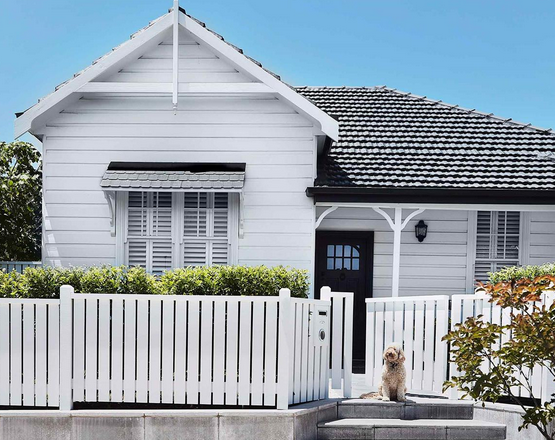
Selling a house is one of the biggest transactions many of us will undertake, so it’s important to whip it into tip-top shape before you list it. To help you with the process, we consulted the experts for their top tips on how to sell your house.
Whose home doesn’t have problems? Whether it’s a dripping tap or rising damp, we can live with these defects and not notice, until we decide to sell. Then it dawns on us: we’re going to open our house to strangers in the hope they’ll buy? Perhaps an update is in order.
While there’s no magic formula for working out which repairs will pay off at sale time, there are a few rules of thumb. Here’s advice from the professionals.
RENOVATION VS. REPAIRS
Changes made pre-sale don’t always mean more money for the property. It means the property is more saleable. Fixing up a problem is one thing, but renovating is another.
It’s pretty difficult to purchase at market price, renovate at retail price, and turn a profit at sale time. It nearly always ends in tears. Those who manage to do it are saved by the market or buy particularly well. It’s usually best to repair over renovate. Attend to maintenance issues but be wary of structural changes.
Kitchens and bathrooms are the most expensive renovations and are not to be taken lightly. Whether to do the kitchen or not depends on the property and what buyers in the area like. If it’s a character-style renovator’s delight, it’s not a good call to put in a new kitchen. But, if a house ticks all the boxes but has an average kitchen, it’s worth putting in a new one to get the house up to its best potential.
If you are going to renovate, you must understand the target market for the house and select your finishes accordingly. And don’t renovate something in the wrong spot. A common mistake is to renovate a bathroom that’s tacked on the back of the house – right where people prefer to have an open-plan living area spilling out to a garden or verandah. The reno is unnecessary and the cost is unlikely to be recouped at sale.
Cracks and damp
Cracks and damp don’t alarm investors or builder/renovators, but there are certain issues that are guaranteed to cause concern to prospective buyers who are in the market for a family home: anything to do with sub-floor ventilation or underpinning, termite risk and damp. Buyers mark it down as above and beyond the cost of the repairs
If your house has major structural issues, and you’re not going to fix the problems, invest in an independent building inspection report yourself, and make this available to buyers.
It’s a way to take the uncertainty and fear out of the equation – buyers can see exactly what the problems are, without having to fork out a small fortune on a prospect they might not pursue. You’re making it easier for buyers to stay interested in your home if they don’t have to guess at what the scary stuff is, or pay a lot of money to find out.
Attention to detail
There are clever things you can do with presentation to distract people.
It’s amazing how little things affect the aesthetic and change the way people see the property, such as pictures on the wall, fresh flowers and curtains, tidy guttering and fascias, or a couple of pot plants.
And, of course, there’s the obvious thing: cleaning. There’s no way around this one. Clean the house like it’s never been cleaned before. Also, attend to doggy smells and declutter.
The great outdoors
First impressions count for everything. People notice the front garden and the general appearance of the property. It’s worth investing in the street presence of your home with fresh paint, new or repaired guttering, a leak-free roof and an inviting garden.
Landscaping may cost one per cent of the property’s value but may increase your selling proposition more than any other renovation on a dollar-for-dollar basis. Even on a very small block (or perhaps especially on a small block), such as you’d find with an inner-city terrace, it’s important, he says, that every square metre looks its very best.
The courtyard needs to be an extension of the home, not some neglected outpost.
The bigger picture
While you’re making repairs and getting everything shipshape – and you’re lucky enough to have some time flexibility – consider a couple of the broader issues around selling your home:
Season
Does your home appeal more at a particular time of year? If you have loads of natural light, central ducted heating and a beautiful magnolia out the front, winter might be the best time to sell. On the other hand, if your home has a great indoor/outdoor flow, and a pool taking pride of place in the backyard, summer is probably your season.
Economy
Look at factors such as where interest rates are sitting, and what the unemployment rate is like. These things affect buyer activity, confidence and lending capability.
Local market
Is your suburb hot at the moment or flat? Are people looking for units or houses, old property or new? Is your place likely to be bought by an investor or an owner/occupier? This last question alone could dictate what kind of changes you make before selling. Discuss these things with your real-estate agent.
Cost
Don’t forget the transaction costs each time you buy and sell. You can lose 8–10 per cent in agent’s fees, stamp duty, legal advice, removal costs, etc.
moving out
Where will you live once you’ve sold your home? Are you looking to buy something else? Is it better to buy before you’ve sold or vice versa? What’s the plan if you can’t time the settlement of your current home with settlement on a new one?
source: homestolove.com.au








